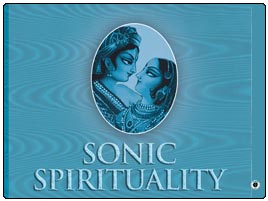New Book on the Hare Krishna Maha-Mantra
By ISKCON News Staff | Дек 06, 2009

“Sonic Spirituality: A Collection of Essays on the Hare Krishna Maha-Mantra” (Vrindavan, India: Ras Bihari Lal & Sons, 2009) is a compilation of articles first published in Back to Godhead Magazine, Integral Yoga Magazine, and a host of other New Age and Yoga journals — all written by Satyaraja himself (as opposed to an edited volume with contributions from other authors).
The book’s first article is excerpted below:
Kirtan Yoga: A Practical Practice for An Impractical Age.
By now we’ve all tried conventional yoga: we’ve sat with eyes closed, in a lotus position — or a facsimile thereof — and we’ve tried various breathing techniques. We’ve meditated on this, that, and the next thing, patiently waiting to enter sacred space, to be lifted from our present plane of consciousness and to be transported to Yogaland.
But for most of us, it just doesn’t happen. The grueling techniques of asana и pranayama can surely bring us to the greatest heights of spiritual awakening — if only we could engage them the way the yogis of old had told us to.
Эта yogis of old, in fact, told us a great many things. One such tidbit is that there are diverse spiritual techniques recommended for various world ages. By the time our present age started, some 5,000 years ago — or so the wisdom texts of ancient India say — the method was supposed to be Kirtan Yoga, the power of sacred chant.
Even Arjuna, Lord Krishna’s friend and devotee (to whom the "Бхагавад-гита" was spoken those multiple centuries ago), found traditional methods of yoga somewhat challenging, and by the Гиты’s Sixth Chapter he rejects them as too difficult. So Krishna compassionately offers an alternative. He tells Arjuna and the rest of us to simply absorb our consciousness in the Divine. This is most effectively accomplished, He says, through consistent uttering of the holy name: “The great souls are constantly chanting my glories.”
As if to confirm Krishna’s ancient words, kirtan — a call-and-response form of devotional singing — is now gaining momentum throughout the world. Yoga studios once known for silent meditation now broadcast tuneful mantras through their loudspeakers, and have special sales on devotional CDs; health food stores and restaurants now support the latest kirtansingers through soft music and New Age magazines. Parts of upstate New York, formerly known as the “Borsht Belt” because it catered to Jewish comedians in the 1940s, 50s, and 60s, are now being re-designated the “Bhajan Belt” – bhajan is an alternate form of kirtan, and its popularity in that area, and elsewhere, is considerable.
And why not? Kirtan is practical. Not everyone has the physical stamina to practice more conventional forms of yoga. But even a child can chant. You open your mouth, and you let your heart sing out. It’s blissful and, under proper guidance, easy to perform.
All the senses are involved. The sound engulfs your ears and tongue; you see the other chanters and perhaps gaze at pictures of deities or divine personalities, teachers who have mastered yogic science; the smell of incense or fresh flowers usually find their way into a kirtan environment; you can play cymbals or a small drum, or even clap your hands, so the tactile sense is engaged as well. One can sit meditatively or get up and dance. Kirtan is a full experience.
By chanting, one naturally engages the breath, which is the perfection of pranayama. The mind is brought under control simply by focusing on the sound – the chitta vrittis, to use yogic terminology, are subdued, thus affording even fledgling practitioners true peace. This is because, by chanting, one is essentially glorifying the supreme with carefully passed-down mantras – word-combinations scientifically conceived by the ancients, putting one in direct touch with Divinity. It is the only form of yoga that benefits not only the practitioner but also anyone within earshot.
In the early stages of the chanting process, one immediately feels good, cleansed, relieved. As one matures in the practice, purification sets in, and an innate happiness rises up in one’s heart. Bad habits gradually fall away. In due course, chanting is healing, nurturing, and fundamentally uplifting. It culminates in an overriding sense of love – for God and for all living beings.
END
For ordering information, please contact Alok at brijwasi2001@hotmail.com















